How to convert Mimecast archive exports
The Enterprise edition of Aid4Mail supports Mimecast SJF exports in their native format. It is able to process these potentially huge archives on-premises, fast and unattended. It even has the unique ability to separate mixed, multi-user exports back into their individual user accounts.
Mimecast archive delivery
Mimecast provides access to archive exports in two different ways:
- (A) Download from the Mimecast server (via FTP). The archive consists of a collection of ZIP files organized by date range but not by email account. Emails belonging to multiple users are mixed together inside.
- (B) Delivery on an external hard drive. The archive usually consists of folders organized by user account. Each folder contains subfolders grouped by date range that, in turn, contain ZIP files of emails for that user.
This page contains video tutorials and instructions to convert both types of Mimecast archive export.
Video tutorials
Convert a downloaded Mimecast archive (A):
Convert a Mimecast archive delivered on external hard drive (B):
Instructions
If you downloaded your archive from the Mimecast server (A), then it needs to be split by email account before it can be converted. Please refer to the article, How to split Mimecast archive exports by email account, before returning here and following the steps in this article.
If your Mimecast archive was delivered on an external drive (B), then it is usually separated by user account already. You only need to convert it. Follow the steps in this article.
Archive structure
Downloaded Mimecast archives (A) that have been split by email account
Archives that were downloaded from the Mimecast server (A) can only be converted with Aid4Mail Enterprise after they’ve been split by email account. If this has not been done yet, please refer to the article How to split Mimecast archive exports by email account before continuing.
After the archive has been split, it will be in the EML format and consist of a collection of folders organized by email address. Each folder contains the emails (EML files) associated with that address. The folder hierarchy looks something like this:
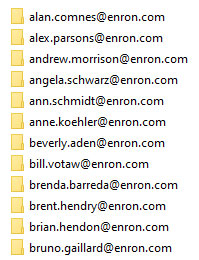
Mimecast archives delivered on external hard drive (B)
Archives delivered on an external hard drive (B) also consist of a collection of folders organized by email account. However, each folder contains subfolders organized by date range. These, in turn, contain ZIP archives with the actual emails. The folder hierarchy looks like this:
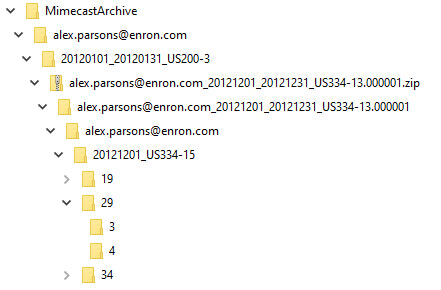
Convert a Mimecast archive
Mimecast archive exports can be extremely large and conversion can potentially take days or even weeks to complete. Before starting, we recommend you optimize Aid4Mail for speed.
In both cases described above, the top level of the archive consists of multiple folders, one per email account. Each of these folders needs to be converted individually. Thanks to Aid4Mail Enterprise’s multi-session processing, and its support for wildcards in file and session names, this is remarkably simple.
In this example, we’re converting to PST. Please follow the steps below. It is assumed that you already have Aid4Mail Enterprise (or a trial version) installed and running.
- Create a new project. Alternatively, if you split your downloaded Mimecast archive using Aid4Mail, you can create a new session in your existing project.
- In the Session name field of the Settings screen, enter an asterisk (*). This is a wildcard and will be explained in more detail later.

- In the Source section of the Settings screen, set the following options:
- Format: If your archive was downloaded from the Mimecast server (A) and split by email account using Aid4Mail, select EML from the drop-down list. If your Mimecast archive was delivered on an external hard drive (B), select Mimecast.
- Files downloaded from Mimecast server: This is only available if you selected Mimecast as your source format. Leave this option unchecked.
- Location: Specify the full path to the parent folder of your archive. Make sure it ends with a backslash (\) and then add an asterisk (*) wildcard to the end of the path. For example: D:\MimecastArchive\*
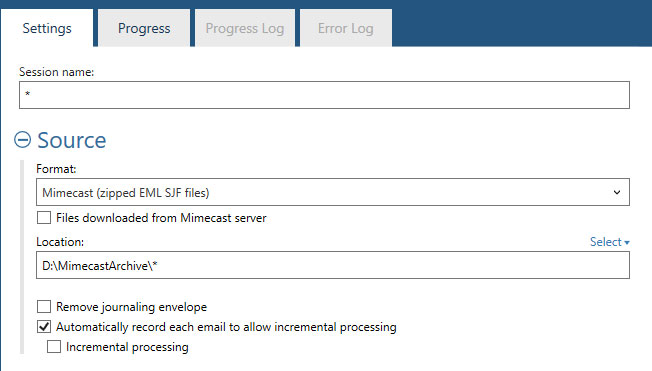
- In the Target section of the Settings screen, set the following:
- Format: Select the mail format you want to convert to. For this example we are converting to PST.
- PST file: Specify the full path of the PST file where each user’s converted mail will be stored, using *.pst as the filename (note that we’re using the asterisk wildcard again). For example: D:\ConvertedArchive\*.pst
- Location in PST file: This is optional. It’s the base folder inside of the PST file where the converted mail will be placed. In our example, we have put Mimecast emails but we could have just left it blank.
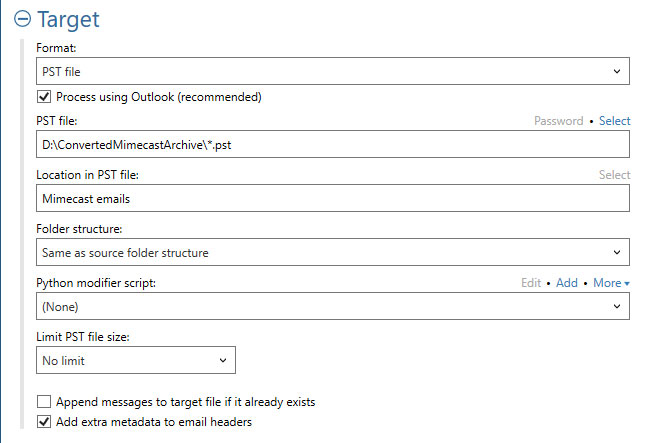
- Make sure the session list is open. You can toggle it open/closed by selecting View > Session list from the main menu. Alternatively use the Show/Hide session list button at the bottom of Aid4Mail’s window.
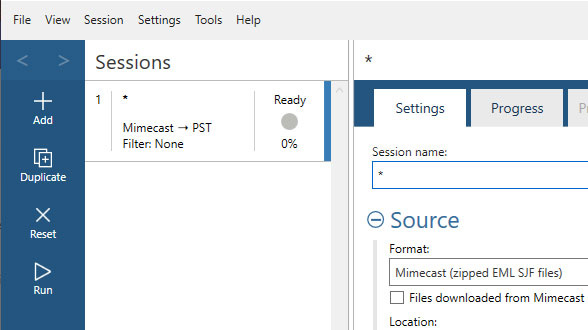
- In the main menu, select Session > Duplicate. Alternatively, use the Duplicate button in the vertical button bar on the left side of Aid4Mail’s window.Aid4Mail will create a session for every email account. This is because of the asterisk (*) wildcard that was used in the settings. Aid4Mail replaces the asterisk in all the source locations with the names of the folders it finds. In this case these folder names are email addresses. It then uses the same text in all other places where the asterisk wildcard was used, i.e. the target PST filenames and the session names.
This technique enables you to build a huge number of sessions very quickly. Once finished, Aid4Mail’s session list will look something like this:
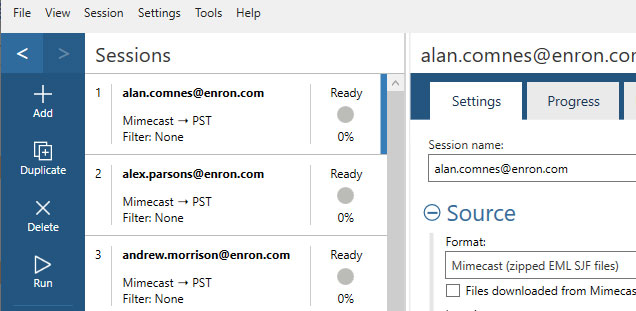
- In the main menu, select Settings > Options to open the Options screen. Choose the Sessions tab. Under the Multiple sessions heading, you can set the maximum number of sessions that can be run concurrently. The optimal number depends on your computer system. A high-performance system can run more tasks simultaneously. You can run some tests to find the optimal number or, if you’re not sure, just leave the default value.Close the Options screen using the X at the top-right.
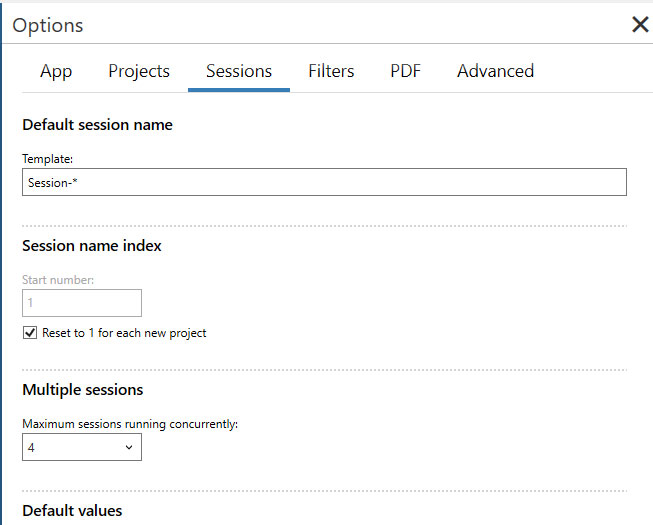
- Finally, in the main menu select Session > Run all, or use the Run all button in the vertical button bar on the left side of Aid4Mail’s window.Aid4Mail will start concurrently processing as many sessions as it can and will queue the rest. When one is finished, Aid4Mail will start on the next one in the queue, and so on until they’re all complete. Aid4Mail does all this unattended, while you’re working on something else. As enormous archives can take days or even weeks to convert, this is potentially a huge time-saver.
Once Aid4Mail has finished processing, your target location should contain a PST file for every user account. Each PST file contains the emails associated with that account.
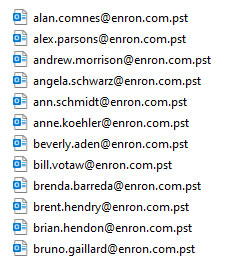
If you experience any issues, don’t hesitate to Contact Us. If you would like to buy an Aid4Mail license, please visit the Aid4Mail store.